Physical Address
304 North Cardinal St.
Dorchester Center, MA 02124
Patients are treated from infancy to skeletal maturity and have unique needs which may change over time.
Comprehensive examination and appropriate workup and referrals for associated medical conditions is imperative.
To provide the best family-centered care, it is important to understand the family’s perspective and their goals for their child.
Patients tend to be incredibly resilient and functional. Many times, surgery can help improve function and decrease deformity, but expectations must be clearly communicated to maximize the chances of satisfaction.
Brachydactyly, literally “short finger”, is a complex entity which may entail much more than the name implies. The proximal limb may be affected and if so, the term brachymyelia with brachydactyly is most appropriate. This section will focus on the hand plate only – brachymetacarpia and brachyphalangia. In order to precisely describe the affected phalanx – proximal, middle, or distal phalanx – the terms brachybasophalangia, brachymesophalangia, or brachytelephalangia, respectively, may be used.
Various gene mutations have been linked to brachydactyly. Brachydactyly may be sporadic or hereditary, and frequently is autosomal dominant with variable expression. It may occur in isolation or as part of a syndrome and has been described as a component of over 50 syndromes.
Brachydactyly is shortening of the digits rather than terminal absence. It is a separate entity from symbrachydactyly – short finger type (described later in this chapter) with a different etiology and phenotypic findings.
Bell described a five-type classification system for brachydactyly in 1951 ( Table 34.1 ). Although this classification has been modified multiple times and various subtypes have been added, the original description remains a good foundation for discussion.
| Type | Description |
|---|---|
| A | Shortened middle phalanges |
| B | Short or absent middle or distal phalanges with deformed thumbs and great toes |
| C | Deformity of the middle and proximal phalanges of the index and middle fingers with shortening of the metacarpals |
| D | Short and broad distal phalanx of the thumb and great toes |
| E | Shortening of one or more of the metacarpals |
Brachydactyly commonly affects the index and small fingers and most often the middle phalanx. However, phenotypes vary, and any combination of digits and phalanges may be affected.
Management depends on the digit(s) affected, whether the condition is brachymetacarpia and/or brachyphalangia, the degree of shortening, and patient/family goals. Management considers both function and appearance, as well as age, physeal development, and future growth. The metacarpal physis may be prematurely closed, and residual growth in adjacent digits is considered.
Surgical intervention is uncommonly performed due to generally excellent function and minimal aesthetic concerns. Occasionally, patients may complain of altered digit cascade and “knuckle” contour ( Fig. 34.1 ). When there is significant shortening or notable deformity in the coronal plate, osteotomy or lengthening may be considered. Unlike many congenital hand differences that are treated before school age, treatment of brachydactyly is often delayed in order to better understand functional limitations and guide decision-making.

First webspace deepening procedures may be performed for treatment of a short thumb or index finger. Deepening the webspace increases the relative length of the digits which may improve large object grasp. Surgical technique is typically a Z-plasty (2-, 4-, or 5-flap), but in a more severely narrowed first webspace, a dorsal advancement flap may be helpful.
Metacarpal lengthening is by either acute or gradual techniques. If the length deficit is relatively short, such that a sliding osteotomy of up to a few cm can correct current and future length discrepancy, then a one-stage procedure may be utilized. This more simplistic approach may be better tolerated by some patients and families. However, gradual lengthening with an external fixator has the potential to gain much more length. The trade-off is that the fixator is in place for several months, and subsequent plating may be necessary if satisfactory bone regeneration does not form. Contralateral hand radiographs help plan goal length if the patient is skeletally mature. Radiographs of the same-sex parent’s hand can also help with planning in the skeletally immature patient. In our experience, the length deficit is typically greater than a onestage lengthening can address; for this reason, distraction lengthening with a uniplanar external fixator is our treatment of choice. If there are multiple short digits, simultaneous lengthening can be accomplished but, in our practice, this is very rarely considered.
The first stage is an osteotomy through a linear dorsal incision. We use the fixator to guide placement of the half-pins. Once the pins are placed, the fixator is removed and an osteotomy is created with great care to avoid generation of heat (which might compromise subsequent bone formation). We leave the periosteum intact. The fixator is then reapplied and the device activated, confirming lengthening and alignment. After a latency period of 5–7 days, we lengthen 0.75 mm/day via three turns spread throughout the day. We assess radiographs weekly and adjust the turning schedule as needed. Once the metacarpal is sufficiently long, we allow the regenerate to mature and assess radiographs every few weeks. The consolidation phase is typically equal to the lengthening phase. If sufficient bone does not form, plating with bone grafting may be required at the time of fixator removal.
For correction of an angular deformity in an already shortened digit, one should give consideration to an opening wedge osteotomy. Variable-shaped phalanges and hypersegmentation of digits (resulting in four small phalanges) pose challenges and opportunities for creative solutions with osteotomies and arthrodeses.
A single short metacarpal may be the most common brachydactyly presentation. Most of these patients are asymptomatic but some have aesthetic concerns and particularly note an absent “knuckle”. Lengthening is an option for these patients, but it is imperative that information be shared with the patient (and family) regarding the time course of the procedure and the risk of complications. In addition, the dorsal scar is noticeable and can be an aesthetic challenge.
Monitoring for bone regeneration during the lengthening procedure is crucial to allow modification of the “turning” schedule. This is best done with weekly radiographs.
When an external fixator is applied, frequent clinic visits, hand therapy, maintenance of the device, and monitoring for hardware-associated complications are important. Superficial infections are quite common and typically respond to oral antibiotics.
In general, outcomes from lengthening metacarpals are more favorable than lengthening phalanges due to challenges with digit stiffness.
Symbrachydactyly means “short, fused digits”, but its spectrum of morphologic characteristics surpasses this definition. There has long been inconsistency and heterogenity in terminology applied to symbrachydactyly resulting in confusion with classification and diagnosis. Our most recent understandings in developmental biology, as well as the adoption of the Oberg, Manske, and Tonkin (OMT) classification, have helped delineate symbrachydactyly as a separate entity from brachydactyly, syndactyly, transverse deficiency, and cleft hand.
In general, symbrachydactyly is sporadic and unilateral. (There are a few exceptions which will be discussed later in the section on diagnosis/patient presentation.) In a study of children born in Stockholm, Sweden, symbrachydactyly occurred approximately 0.6 in 10,000 live births and affected the left upper extremity twice as commonly as the right.
While the etiology of symbrachydactyly is still debated, many believe that a vascular insult to the progress zone mesoderm beneath the apical ectodermal ridge is the critical issue. This affects the proximal to distal axis in development, and the timing of the insult influences severity. Phenotypes vary based on timing of the insult, with more severe types and more proximal levels of symbrachydactyly corresponding to earlier injury. Symbrachydactyly results from a mesoderm-only insult – the ectoderm is much less affected – and thus nubbins form with preserved nail plate ectodermal elements, including portions of the distal phalanx.
Symbrachydactyly may involve the hand plate alone or the entire upper extremity. The key to making an accurate diagnosis of symbrachydactyly is the presence of nubbins with nail plates – this is the hallmark characteristic ( Fig. 34.2 ). Reconciling various phenotypes under the category of symbrachydactyly is aided by recognizing that symbrachydactyly is a predictable spectrum. The four-part classification by Blauth and Gekeler describes the spectrum of hand differences in symbrachydactyly – short finger type, oligodactylic, monodactylic, peromelic ( Fig. 34.3 ). In the short finger type, the hand is small and multiple digits are affected, often with incomplete syndactyly of the webspaces and/or small or absent middle phalanges. The thumb usually appears relatively normal. In the oligodactylic type, the thumb and small finger are better preserved than the central digits. This previously was called “atypical cleft hand”, but that nomenclature has been abandoned. In the monodactylic type, the thumb is the single digit present, sometimes stable and sizable but other times short and unstable. In the peromelic type, there are nubbins with nail plates, and metacarpals may or may not be present. When digits are suppressed, nubbins with nail plates persist – this characteristic is unique to symbrachydactyly and aids in making the diagnosis. Patients with symbrachydactyly often have mild shortening and narrowing of entire upper extremity. This can include a generalized shortening with a radius and ulna which are proportional to each other but shorter than the contralateral unaffected forearm.
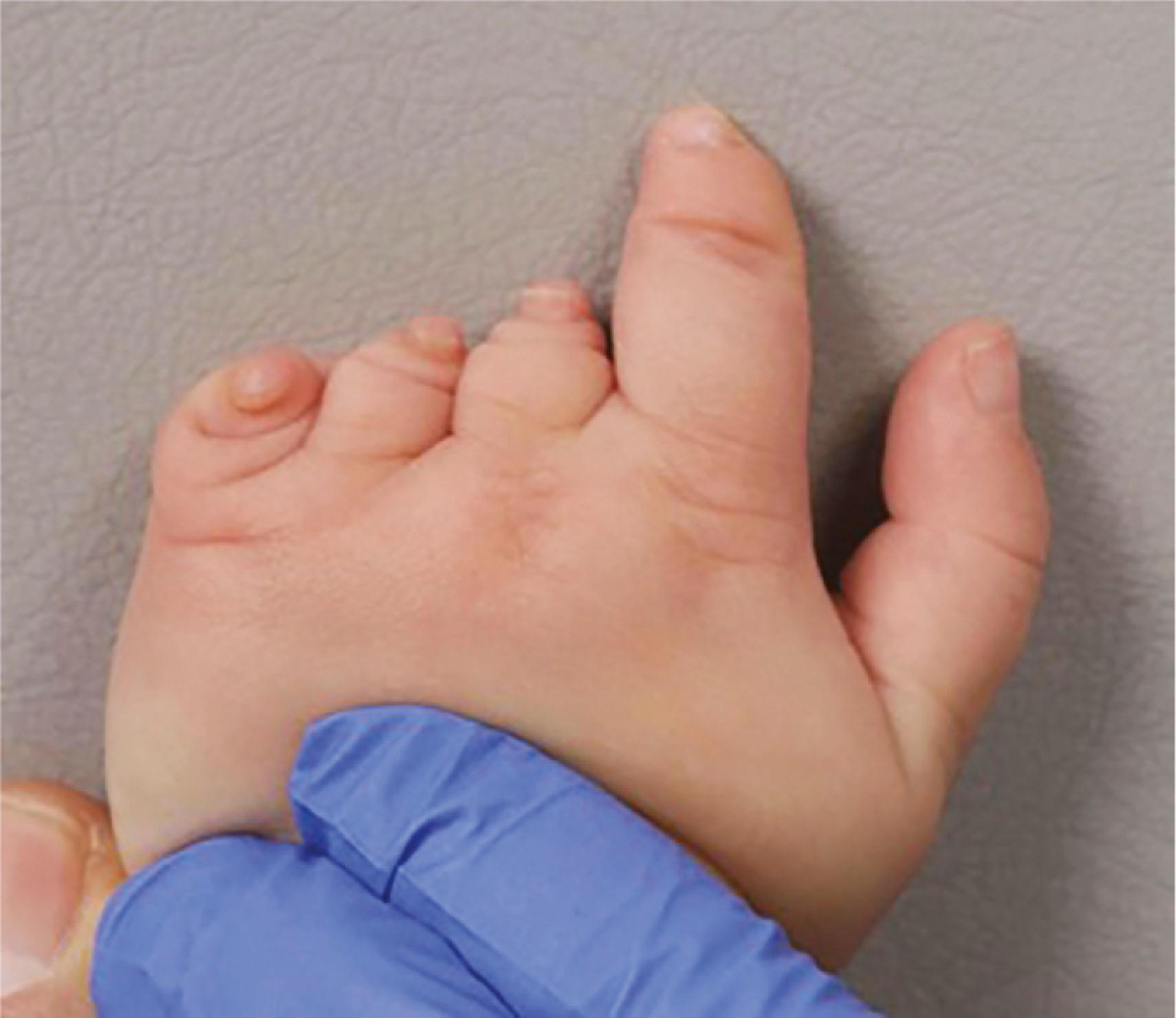
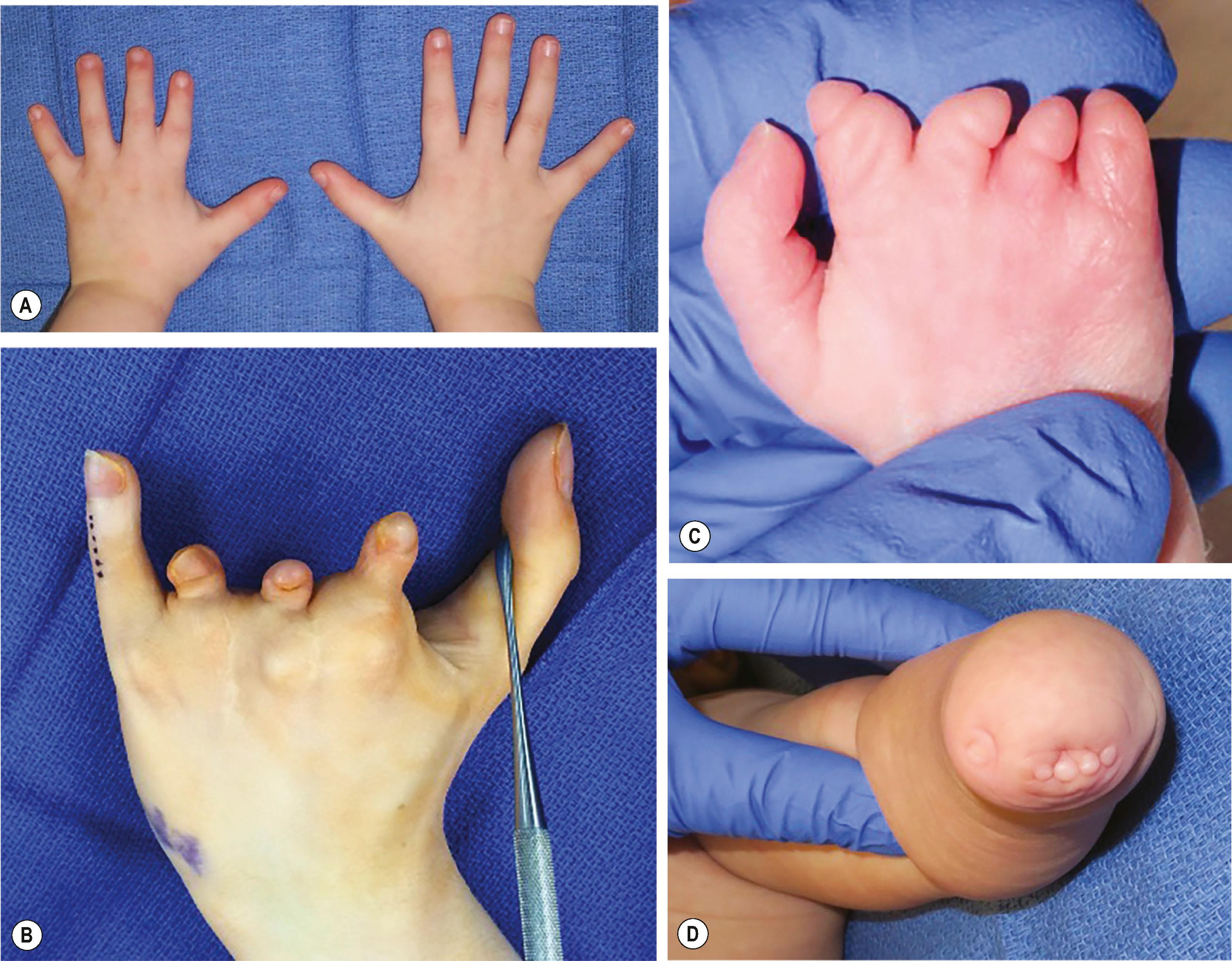
Though not described in the classification system by Blauth and Gekeler, the level of symbrachydactyly can extend proximal to the hand plate – with shortening through the carpus or forearm with characteristic nubbins with nail plates, soft tissue invaginations, and proximal bone tapering of the stump. Yamauchi and Tanabu described a seven-type classification that encompasses both hand and forearm differences in symbrachydactyly. In their classification system, the first four types describe hands with progressive decrease in the number of phalanges. Type 5 hands have a missing metacarpal, type 6 has absence of all digits as well as abnormal carpal bones, and type 7 is forearm amputation type. In type 7, the amputation is through the distal forearm and there are nubbins with nails on the stump. The elbow is normal.
The most notable association with symbrachydactyly is Poland sequence (discussed in detail in Chapter 33 ). All patients with symbrachydactyly are carefully examined and particular attention given to the chest wall ( Fig. 34.4 ). The sternal head of the pectoralis major is deficient in Poland sequence, and in severe types ribs may be deficient or absent as well. Poland sequence is most common with the short-finger type of symbrachydactyly. Aside from rare instances when it is associated with Möbius sequence and bilateral, symbrachydactyly is otherwise unilateral. Rarely, symbrachydactyly is associated with other conditions such as Klippel–Feil, Turner syndrome, and DiGeorge sequence.
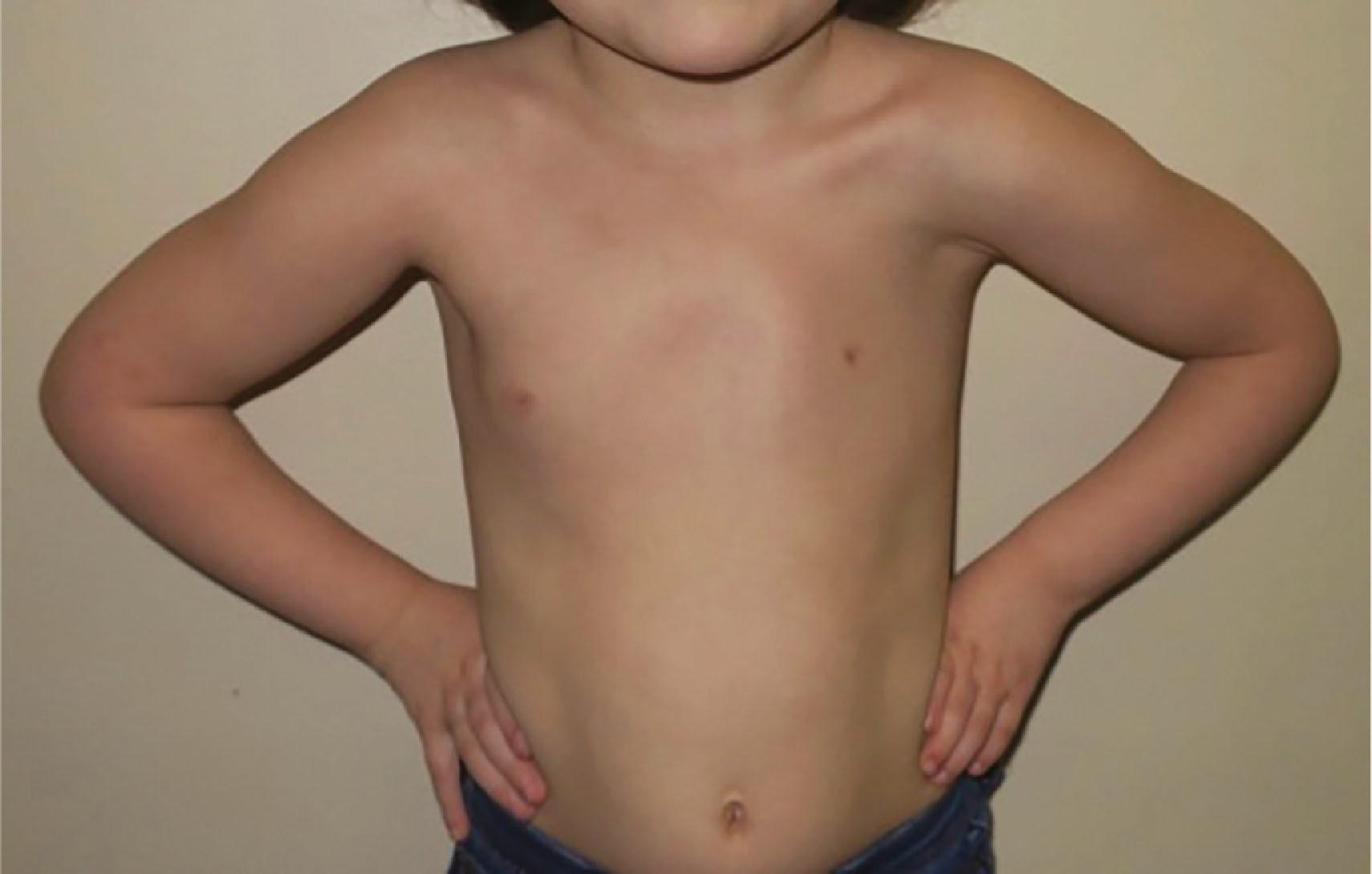
Nubbins in symbrachydactyly and amniotic constriction ring sequence differ in appearance. In amniotic constriction ring sequence, the terminal stumps lack nail plates and frequently coexist with acrosyndactyly (fenestrated syndactyly) and multiple bands on more than one extremity. These characteristics help differentiate the two diagnoses.
The affected limb typically functions as a helper extremity unless very mildly affected. Surgery is considered if functional or aesthetic gains are promising. Rarely, prosthetics may have a role. Timing of surgery depends on the digits involved as well as the indication – incomplete syndactyly, web contracture, brachydactyly, digit instability, digit absence, and/or lack of opposition. Early indications for surgery are to reconstruct the first webspace in order to facilitate grasp and pinch. Surgery often commences at approximately 18 months of age with the goal to complete reconstruction prior to school age.
We do not encourage removal of nubbins. Nubbins are sensate and often useful for push or general function. Some families express a desire to remove nubbins for appearance or hygiene issues, and we believe these are reasonable indications for this straightforward intervention.
Syndactyly in symbrachydactyly is typically incomplete and cutaneous and reconstructed using standard techniques. If passive interphalangeal joint motion is minimal, expectations for improved interphalangeal joint motion should be guarded – and incisions along the digit interspaces may be straight rather than zig-zag.
The first webspace is optimized, often through first webspace deepening procedures. These might include 2-, 4-, or 5-flap Z-plasties or rotation flaps for more significant deficiencies.
Thumb reconstruction in symbrachydactyly deserves particular mention. The thumb is usually the best-formed digit. However, when significantly affected, it is often similar to a hypoplastic thumb described in Blauth types I, II, or IIIa.
Length, stability, first webspace, and opposition should be optimized by standard techniques as described in the section later in this chapter on hypoplastic thumbs. If the thumb is positioned in the plane of the palm, and abduction–rotation osteotomy of the metacarpal with webspace deepening may improve function. Standard tendon donors for opposition transfer may not be available; if present, tendon excursion should be tested prior to transfer given the potential for abnormal myotendinous structures.
Shortened digits are most commonly treated nonoperatively. However, if lengthening is desired, non-vascularized toe phalanx transfers, free vascularized toe-to-hand transfers, and/or distraction lengthening are options.
For short metacarpals or phalanges with adequate distal soft tissue, non-vascularized toe phalanx transfer may improve length. “Adequate distal soft tissue” refers to redundant skin overlying the bone, and it often has a wrinkled appearance ( Fig. 34.5 ). The proximal (or less commonly middle) phalanx of the third of fourth toe may be used as the donor. The second toe is avoided to preserve it for free second toe transfer should family desire that reconstructive option in the future. The phalanx is harvested extraperiosteally and with soft-tissue attachments in order to maximize potential physeal growth. In order to minimize instability, chondrodesis may be performed proximally. The phalanx is secured in its new location with sutures and a Kirschner wire (K-wire). The optimal age for performing non-vascularized toe phalanx transfer is debatable. Some advocate performing the procedure early to maximize remaining physeal growth. However, the effect of age on remaining growth is controversial, and others recommend waiting until 3–4 years of age when a more sizable bone is available for transfer and there is less dependence on future growth. Subsequent distraction lengthening of the transferred phalanx at a second stage may be performed.
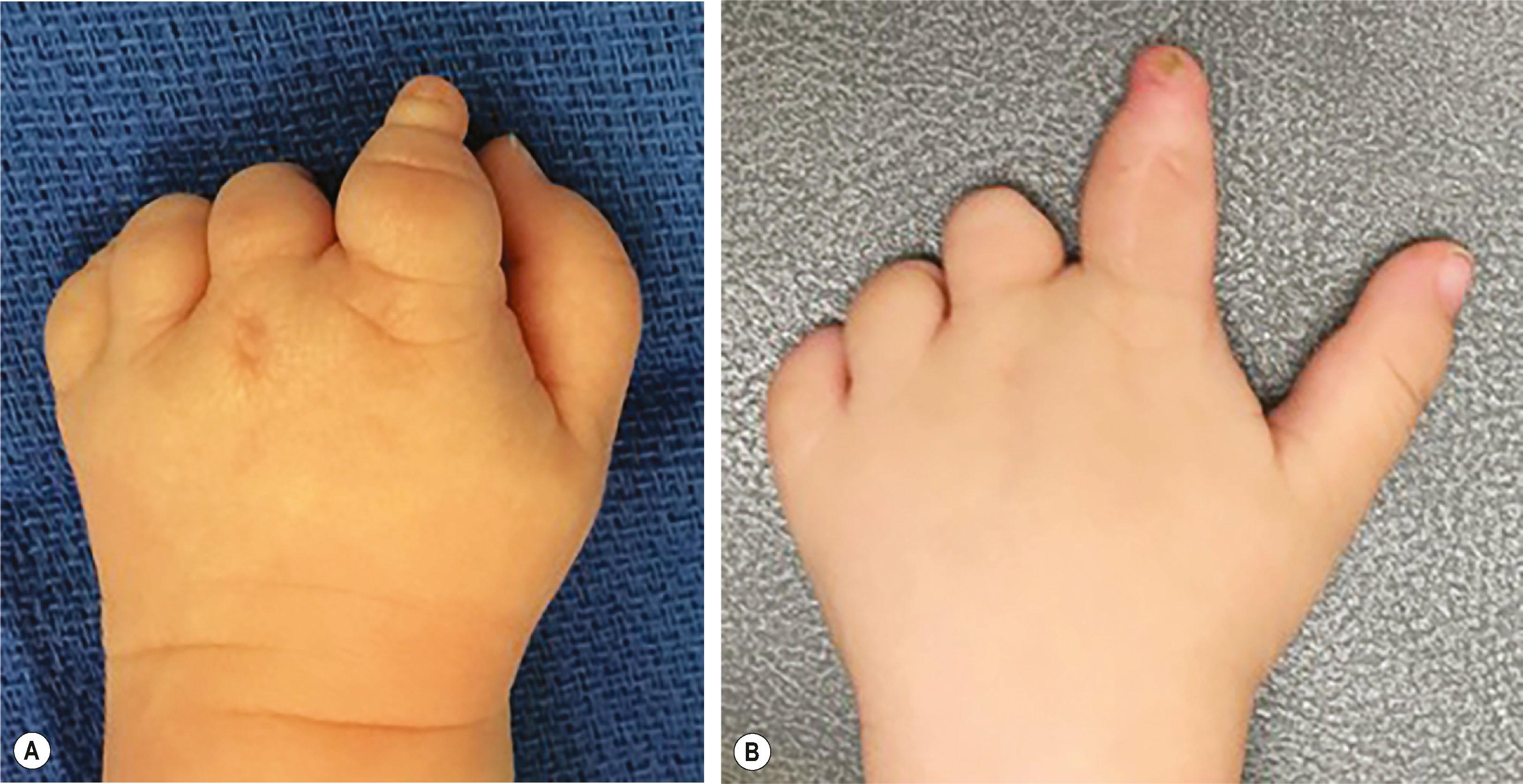
Single or bilateral free second toe-to-hand transfers have a role in symbrachydactyly digit reconstruction ( Fig. 34.6 ). Goals are to facilitate pinch and grip as well as create the appearance of a more “complete” hand. Proximal myotendinous and neurovascular structures may be hypoplastic. Preoperative computed tomography angiography (CTA) is helpful to evaluate recipient vessels.
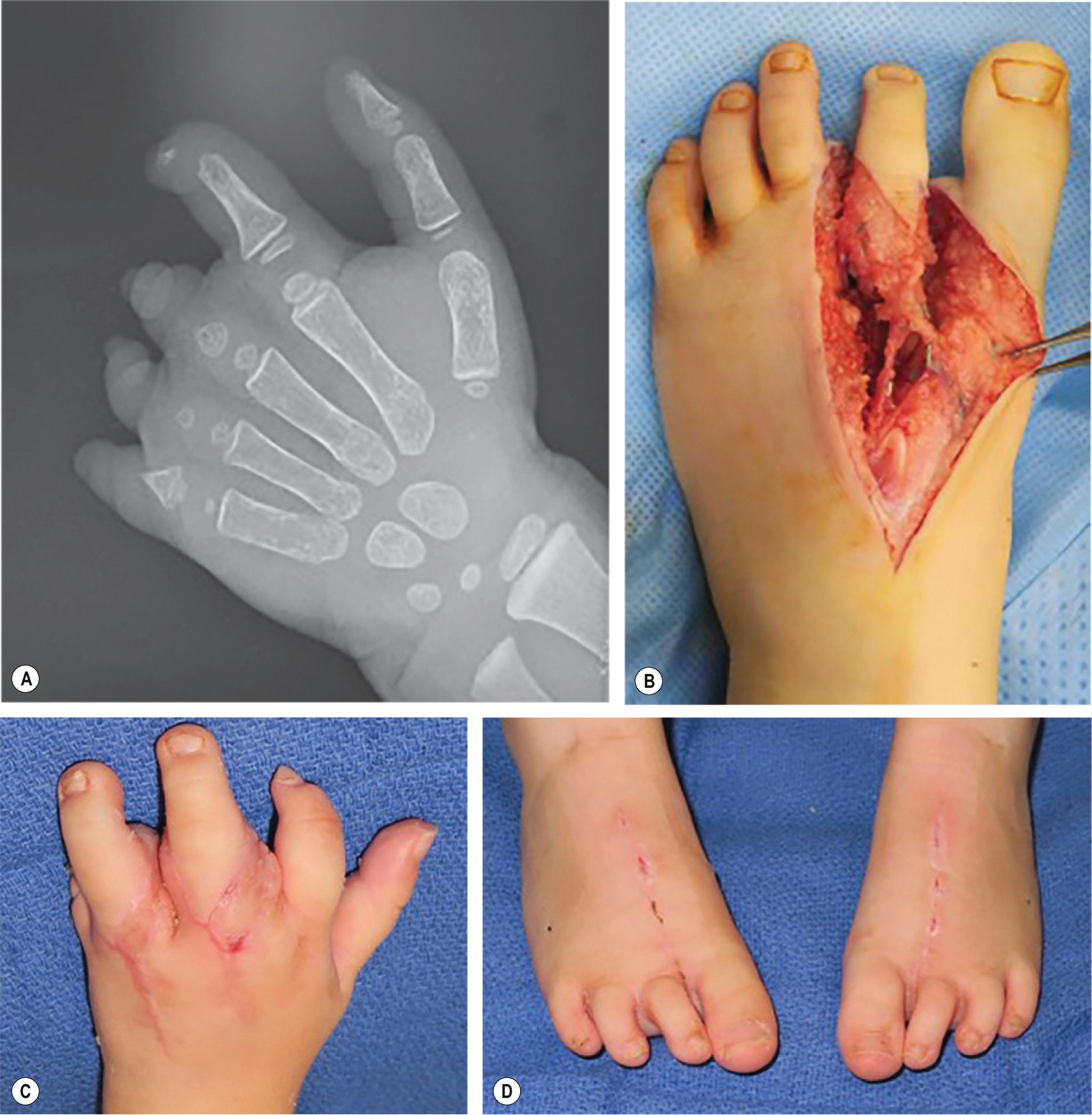
Distraction lengthening with or without intercalary bone grafting may be performed in symbrachydactyly. The most common indication is to create a post for the thumb to pinch against. Often this is the 5th metacarpal. Standard distraction techniques are used and multiple digits may be simultaneously lengthened. If the thumb is lengthened, we have found it is important to pin across the thumb carpometacarpal (trapeziometacarpal, TMC) joint to stabilize and protect it from secondary deformity.
Removal of nubbins is either done early at the family’s request or becomes an unlikely option later in life. As children grow accustomed to the nubbins, sentimental value is attached to them even if function is not aided.
Thumb metacarpal lengthening can improve function when first webspace deepening is insufficient. The thumb carpometacarpal (TMC) joint is held with a Kirschner wire to minimize the risk of TMC joint instability during the lengthening process.
After pinning transferred phalanges, immobilization in a splint is continued for several weeks. Meticulous pin care is needed with distraction lengthening devices. Distraction should be stopped or slowed if there are signs of overlying skin compromise or significant pain.
Whether non-vascularized toe phalanx transfer leads to improved function and/or appearance is debatable, and long-term outcomes are lacking. Several studies have evaluated growth of the transferred phalanx and their findings vary widely. It is important to distinguish between physeal patency and physeal function when assessing radiographic outcomes. Netscher emphasized that the amount of growth achieved through the physis of the transferred phalanx is not the end goal – but rather, the transferred phalanx sets the foundation for digital separation and distraction lengthening, the ultimate goal being distraction lengthening to potentially achieve more length than one could from a functioning toe phalanx physis.
Toe donor site morbidity is considerable, increases over time, and should be discussed with families preoperatively. Some advocate for autogenous corticocancellous bone grafting the donor site to minimize toe shortening and instability, though some amount of shortening is likely to still occur.
Functional outcomes after free vascularized toe-to-hand reconstruction for symbrachydactyly have been reported. Growth and function are usually satisfactory while motion is variable. Psychological outcomes after toe-to-hand transfer in children are encouraging.
Our enthusiasm for distraction lengthening in symbrachydactyly is somewhat tempered by high complication rates (approximately 30%) and lack of research evaluating function and appearance outcomes after distraction in this particular cohort. Nonetheless, when a post is needed for thumb pinch, we think it is a very good option with reliable outcomes.
Transverse deficiency is uncommon, and its etiology has not been confirmed. It is sporadic, unilateral, and occurs at various levels from hand to upper arm.
The etiology of transverse deficiency is believed to differ from that of symbrachydactyly and constriction ring sequence. Transverse deficiency results from an insult to the apical ectodermal ridge. This leads to a lack of ectodermal elements (absent nail plates on nubbins) and cessation of further outgrowth after the insult. Timing influences the level of transverse deficiency, with a shorter residual limb corresponding to an earlier insult. In contrast, symbrachydactyly results from an insult to the developing mesoderm with preservation of the overlying apical ectodermal ridge – and thus has preserved ectodermal elements. In the OMT classification, constriction ring sequence is a deformation process (the insult affects a part already formed), whereas transverse deficiency is a malformation (abnormal formation/differentiation).
Transverse deficiency is often detected on prenatal ultrasound and can occur anywhere along the upper extremity. Distally, common levels are at the wrist (carpus absent, at proximal carpal row, or at distal carpal row), metacarpal, or phalangeal levels (proximal, middle, or distal). At the digit level, the stumps are thick and bulbous. The extremity proximal to the arrest is normal.
The key to making the diagnosis of transverse deficiency versus symbrachydactyly is the presence or absence of ectodermal elements (i.e., nail plates) at the end of the stump or nubbin. Transverse deficiency does not have ectodermal elements, whereas symbrachydactyly will have ectodermal elements present.
Several characteristics distinguish constriction ring sequence from transverse deficiency. When a shortened digit is secondary to constriction ring sequence, there is usually additional visible evidence of amniotic banding in the form of indentations or acrosyndactyly elsewhere on the patient, and multiple extremities are commonly affected. Radiographs of digits truncated by constriction bands show phalanges tapered at the tip and, clinically, the overlying soft tissue is usually tight and adherent to the bone. In contrast, transverse deficiency lacks these features – the bones do not taper to a point, and the soft tissue is loose and bulbous appearing.
Most patients with transverse deficiency are treated without surgery. The affected extremity is sensate and used by the child, and proximal limb structures are typically developmentally normal. While principles and techniques for digit lengthening or reconstruction described in the prior section on symbrachydactyly may be applied to transverse deficiency, it is rarely indicated. Occasionally, surgery on the amputation stump simplifies prosthetic fitting.
When prosthetics are fitted at a young age, there is a high abandonment rate. A large multicenter study from Shriner’s Hospitals by James et al. studied prosthetic use in children with unilateral congenital below-the-elbow deficiency and questioned whether it was associated with better quality of life and better function. They evaluated results of parent- and child-reported health-related quality-of-life and musculoskeletal health questionnaires as well as subjective and objective functional testing of children with unilateral congenital below-the-elbow deficiency with and without a prosthesis. They reported that prostheses may help with social acceptance or be useful as tools for specialized activities, but that they did not improve function or quality of life, which were nearly normal for children with unilateral congenital below-the-elbow deficiency regardless of whether they wear a prosthesis. This study called into question the prior standard practice of fitting infants with prostheses.
We agree with this paradigm change and also now recommend prostheses in a task-specific manner when children are older, when there is a specific need or request, and when children can participate in choosing the type of prosthesis that fits their individual need ( Fig. 34.7 ). A multidisciplinary team consisting of a pediatric occupational therapist, psychologist, prosthetist, orthotist, and rehabilitation specialist is invaluable – as are peer groups of children with similar upper extremity differences.
Surgical intervention is rare for patients with transverse deficiency. Patients are highly functional and intervention, whether surgical or via prosthesis, is based upon the potential for functional improvement. Hand therapy input and physician time spent with the family are key components to understanding potential benefits of intervention.
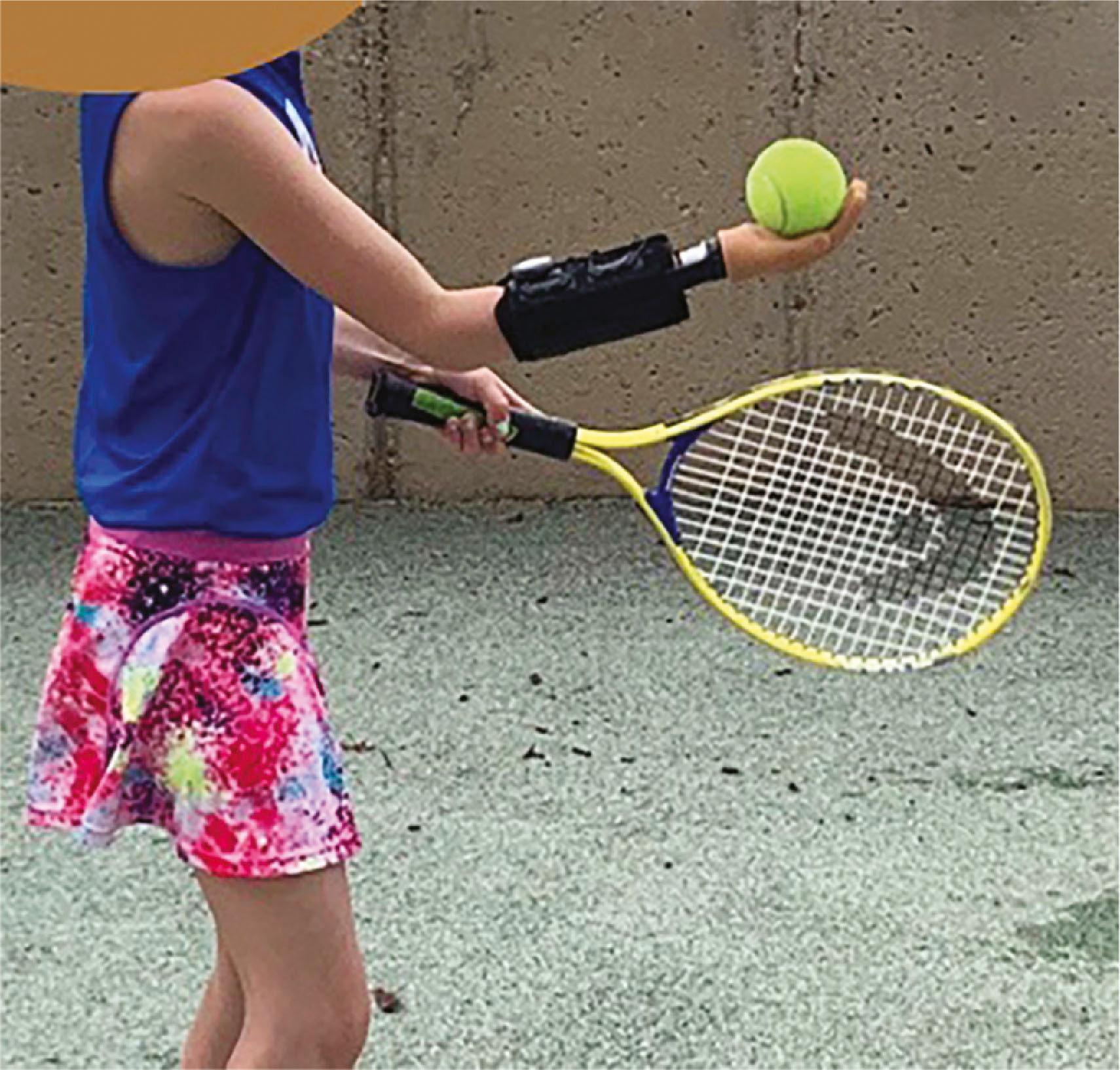
Cleft hand is an isolated deficiency of the central hand which has a predictable spectrum of phenotypes. Compared to those with sporadic inheritance, cleft hands with an identifiable genetic etiology tend to be more severe, bilateral, and also involve the feet. Adrian Flatt memorably described cleft hand as “a functional triumph and a social disaster” – a sentiment which appropriately emphasizes the fundamental issue in treating children with cleft hand – typically very good function but challenging appearance.
Cleft hand results from an injury to the central portion of the apical ectodermal ridge in the developing limb bud. The injury affects both the ectoderm and mesoderm. Elegant studies by Ogino and his team support a close relationship between cleft hand and complex syndactyly and synpolydactyly.
Cleft hand has been associated with multiple syndromes: split hand foot malformation (SHFM) (OMIM #183600, 313350, 246560, 605289, 606708), ectrodactyly ectodermal dysplasia (EEC) (OMIM #129900, 604292), ectrodactyly cleft lip/palate (OMIM #129830), Cornelia de Lange (OMIM #112470, 300590, 610759, 614701, 300882), acrorenal syndrome (OMIM #102520), focal dermal hypoplasia (OMIM #305600), ectrodactyly and mandibulofacial dysostosis (OMIM #183700), ectodermal dysplasia ectrodactyly and macular dystrophy (OMIM #225280). Split hand foot malformation (SHFM) is the most common syndromic association and is usually autosomal dominant with variable penetrance, though de novo mutations may occur. Phenotypes may vary in each generation – and classically, both hands and both feet are affected ( Fig. 34.8 ).

Cleft hand is commonly bilateral, and the extremity proximal to the carpus is normal. The key to making an accurate diagnosis is recognizing the predictable spectrum of morphology as outlined in Manske’s classification as well as its close association with complex syndactyly. The classic appearance is a deep central V-shaped split in the hand with an absent central digit (ectrodactyly), frequently with aberrantly oriented bones and syndactyly adjacent to the cleft ( Fig. 34.9 ).
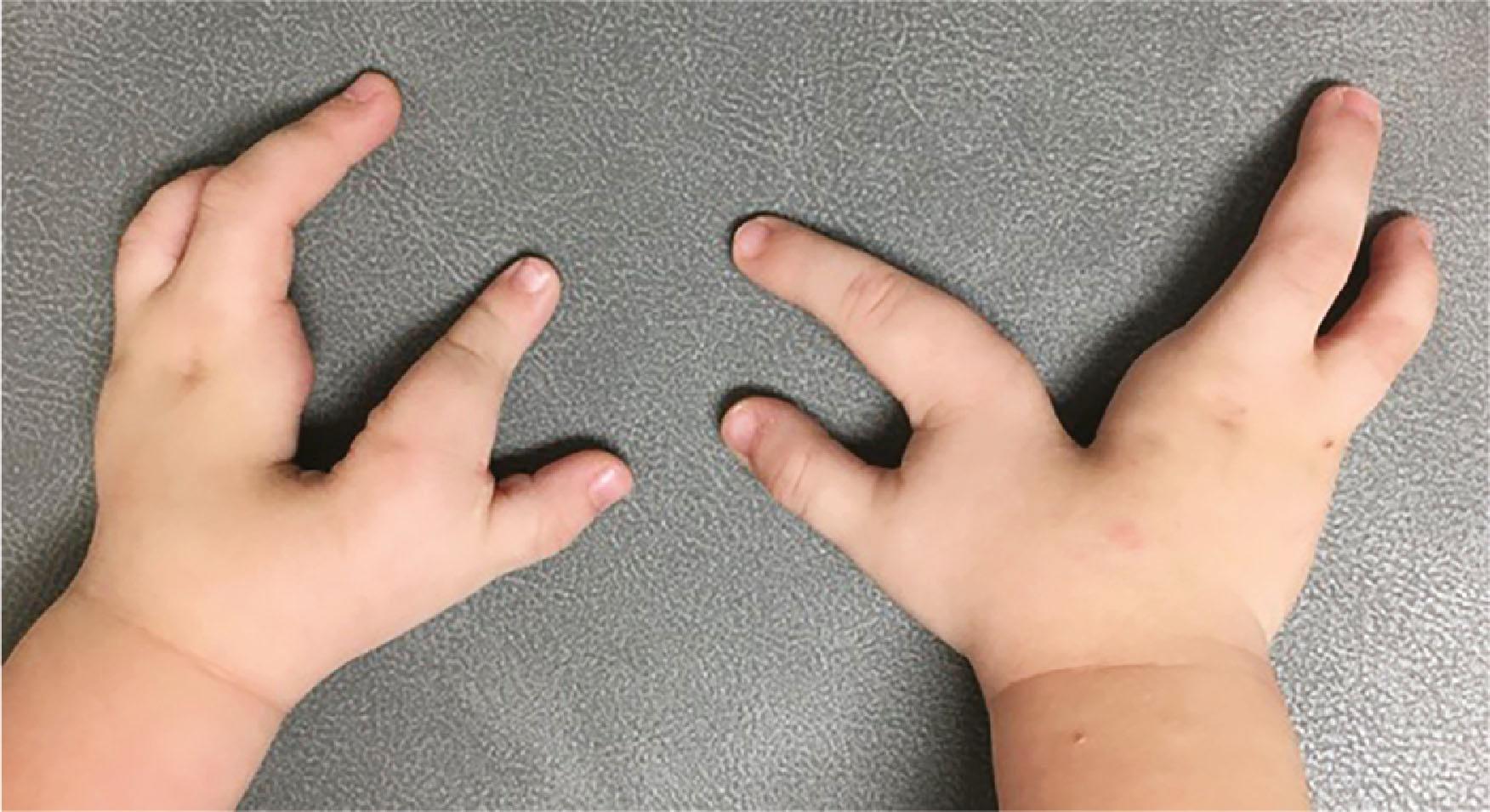
Cleft hand should be differentiated from the oligodactylic form of symbrachydactyly which tends to have a broad, shallow, U-shaped appearance with nubbins (see Fig. 34.3 B). Symbrachydactyly has a different etiology, is almost always unilateral, and has finger nubbins with nail plates as a notable clinical finding (see section on symbrachydactyly for more details).
Manske’s classification focuses on the thumb and first webspace ( Table 34.2 , Fig. 34.10 ). He described a deep central cleft followed by progressive narrowing of the first webspace, syndactylization of the index and thumb, merging of the first webspace with the central cleft, and ultimately suppression of the radial digits with only a small finger remaining. Since maximizing function of the thumb and first webspace is crucial to overall hand function and guides treatment decisions, we find this classification system very useful. Other classifications based on the number of affected rays and the number of missing bones may be useful for description but rarely for treatment. Manske’s classification outlines a clear progression of deformity and helps reconcile how a hand with an absent central ray and a hand with only a small finger remaining exist on the same spectrum. Various numbers of digits may be absent in cleft hand – but at least one digit, the small finger, always remains. In contrast, when a single digit remains in symbrachydactyly, it is always the thumb.
| Type | Description | Characteristics |
|---|---|---|
| I | Normal web | Thumb webspace is not narrowed |
| IIA | Mildly narrowed web | Thumb webspace is mildly narrowed |
| IIB | Severely narrowed web | Thumb webspace is severely narrowed |
| III | Syndactylized web | Thumb and index rays syndactylized, webspace obliterated |
| IV | Merged web | Index ray suppressed, thumb webspace is merged with the cleft |
| V | Absent web | Thumb elements suppressed, ulnar rays remain, thumb webspace no longer present |
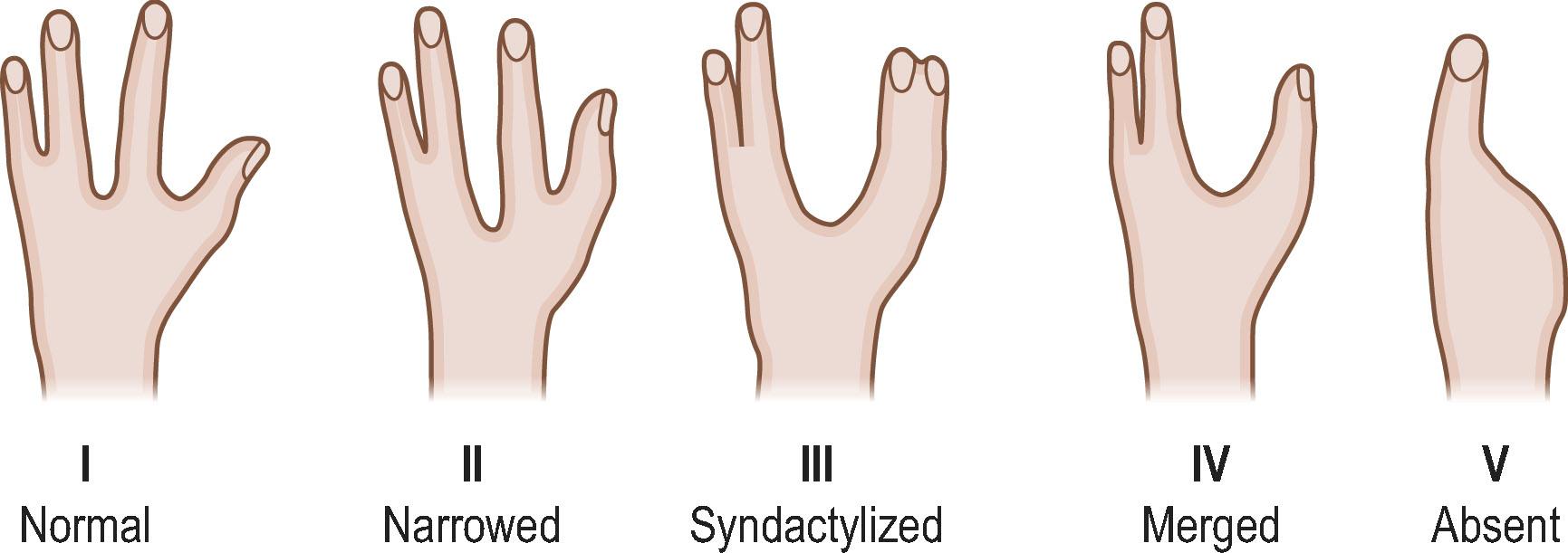
In addition to changes in the thumb and first webspace, digits are often angulated and/or malrotated. Transverse bones and abnormally shaped physes may be present. There is often a flexion contracture of the ring finger due to a lack of intrinsic muscles in the cleft.
The dilemma between form and function, and the imperative to maintain function, is a primary consideration in decision-making for patients with cleft hands. In general, there are two key indications for early surgery at 6–9 months of age – the presence of a transverse bone and syndactyly of border digits. Transverse bones have open physes and will increase deformity if left untreated. Syndactyly of border digits often causes flexion of the longer digit which can be difficult to correct if not addressed early.
Additional indications for surgery, although typically considered at 18–24 months of age, are first webspace reconstruction, cleft closure, and thumb reconstruction. The first webspace is prioritized because of its functional significance. Radiographs are vital to understanding this highly variable condition and also help with surgical planning by delineating bony morphology and aberrant physes.
Removing transverse bones (typically proximal phalanges) with open growth plates is recommended. The transverse bone is typically between the metacarpophalangeal (MCP) joints of the ring finger ulnarly and an index finger radially (if present) ( Fig. 34.11 ). In addition to bony excision, we attempt to stabilize the affecting MCP joints with local tissue and consider collateral ligament reconstruction at a later time as joint instability can be a persistent issue.
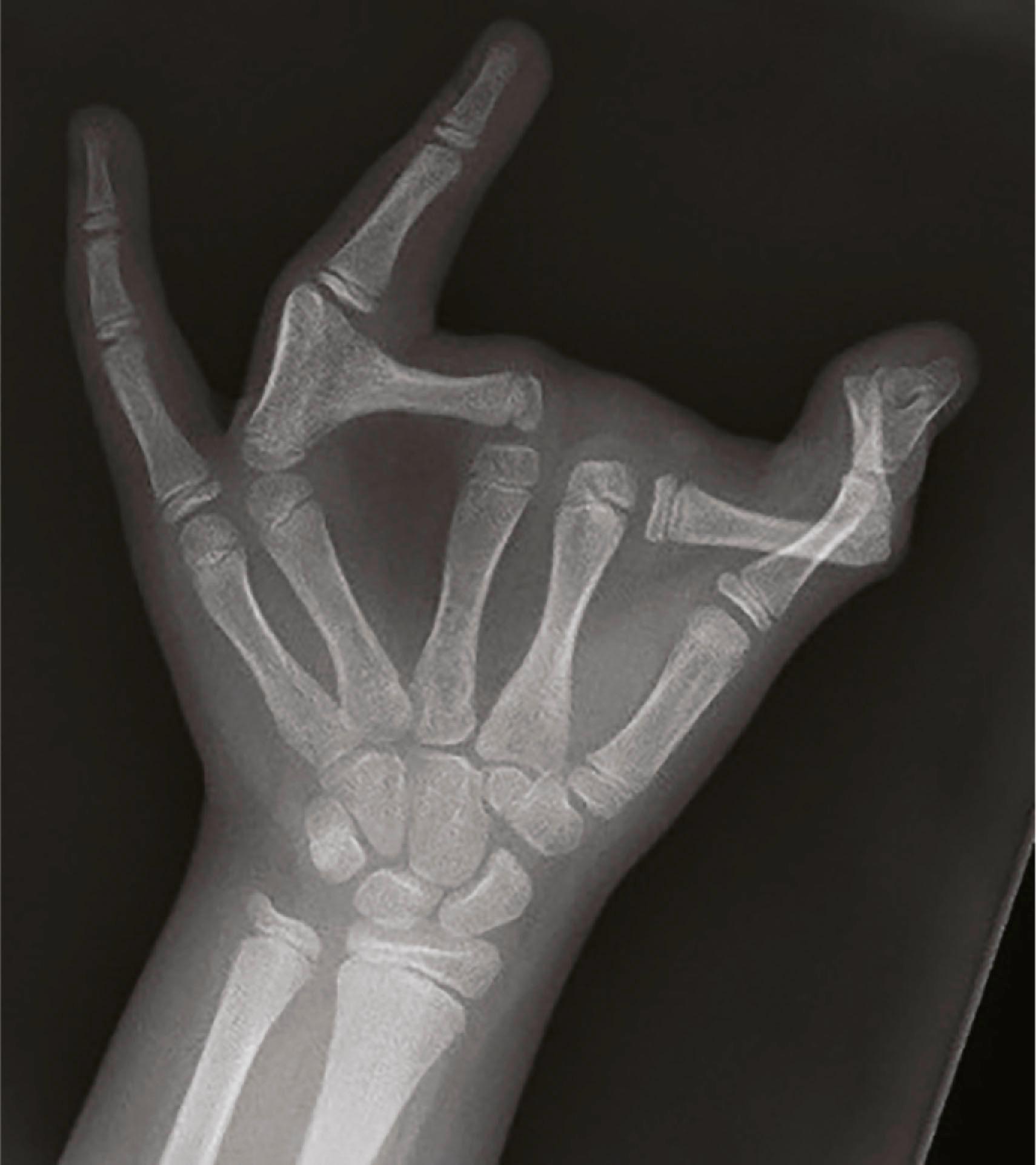
Principles of syndactyly reconstruction apply. The surgeon should be mindful of abnormal branching of digital vessels and consider the possibility of absent blood supply particularly on the side of the digit shared with the cleft.
In Manske type IIA and IIB cleft hands, first webspace reconstruction is often combined with cleft closure. Flaps from either the volar and/or dorsal hand may be used as adjacent tissue transfers to reconstruct the first webspace, and a variety of creative flap designs have been described. The goal is to reconstruct the first webspace with a flap that has a low risk of distal flap necrosis and avoids skin grafts. Our preferred approach was described by Miura. In Manske type III cleft hands, the thumb and index finger are syndactylized (often complex) and may not have normal bone or soft-tissue development. While syndactyly reconstruction is considered in these cases, we also consider removal of the index finger phalanges as it can improve thumb function, versus an independent, hypoplastic index ray which does not improve function or aesthetics.
Isolated cleft closure is considered when the first webspace is satisfactory, but the cleft is deep. When closing the cleft, skin flaps are elevated, myotendinous and neurovascular structures are dissected, and tethering intrinsic muscles are released and later repaired. Myotendinous structures and pulleys may be shared, and there is an increased propensity for aberrant or absent digital vessels along the cleft margin. Skin from the cleft is used to recreate a commissure.
When the first webspace is tight and the cleft is problematic, the skin of the cleft is used to widen the first webspace. In addition, the index finger may be transposed in an ulnar direction to narrow the cleft. While an intermetacarpal ligament (IMCL) may be reconstructed for long-lasting stability, bony alignment and stability are most important. Digits are assessed for angulation and rotation, and correction at the initial surgery is recommended if there are any concerns. Physes may be aberrantly shaped and require attention.
Ring finger proximal interphalangeal (PIP) joint flexion deformity is common due to lack of intrinsic muscles in the adjacent cleft. While reconstruction and tendon transfers may be considered, many times this is well tolerated without correction.
Free toe-to-hand transfer for thumb reconstruction may have a role in Manske type V cleft hands with an absent thumb and an isolated small finger, but in our experience is rarely performed. Associated cleft foot deformity makes toe transfer more challenging and may deter families from even considering it.
We strongly believe that bony alignment is key. When transposing the index ray, intermetacarpal ligament (IMCL) reconstruction is not mandatory. Furthermore, reconstructing an IMCL without assuring bony alignment and a bony “closing” of the cleft is insufficient.
In the classic cleft hand with an isolated absence of the middle finger ray, instability of the index finger metacarpophalangeal (MCP) joint may be problematic. This is especially true after a transverse bone is removed. Soft-tissue stabilization at the time of cleft closure can help, but assuring bony alignment is crucial. We do not consider secondary reconstruction/stabilization of the MCP joint until the physes are closed, and it is clear that it is causing a functional limitation.
Become a Clinical Tree membership for Full access and enjoy Unlimited articles
If you are a member. Log in here